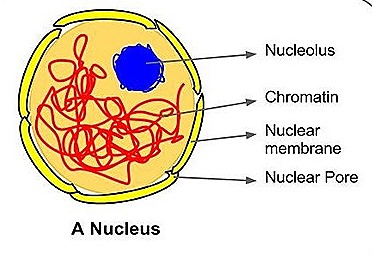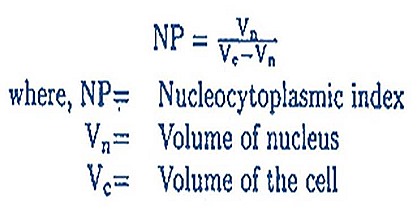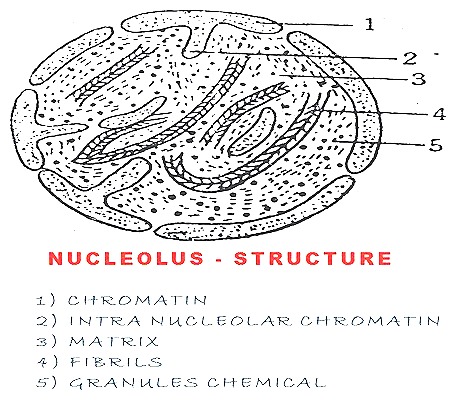CELL NUCLEUS STRUCTURE-FUNCTION
Structure and Functions of NUCLEAS In Cell
In 1832 " Robert Brown" discovered nucleus. It is the essential part of the cell
A definite nucleus is absent in prokaryotic cell. Instead of it a DNA molecules is present. It is called by “Prokaryotic cell". Ex : Bacteria.
Definite nucleus is present. It is covered by nuclear membrane.

The position of a nucleus in the cell is definite. It occupies more or less central position. Now and then it is pushed to die periphery.
Number:
a) Anurfeate: Nucleus is absent Ex : RBC of mammal
b) Mononucleate : It is very common. Usually the cell contains a single nucleus
b) Binucleate : Two nuclei are present. Ex : cells of cartilage.
c) poly nucleate: Three to many nuclei are present. In animals poly nucleate cell is called "Syncytial cell". Ex : Syncytial cell of osteoblast.
.
Shape :
It is usually oval. But its shape is dependent on the cell type.
a) Cylindrical: Ex : Columunar epithelium.
b) Horse shoe shape : Ex : Paramecium meganucleus.
c) tri lobed nucleus : Ex : WBC of mammals.
d) branched nucleus : Ex : Silk spining cell of insect larvae.
e) irregular nucleus : Ex : Glandular cell of insect.
Size :
The size of the nucleus varies with cell type . It is directly proportional to the amount of cytoplasm. "Hertwig " gave nucleo plasmic index.

Structure :The nucleus will show.
a) Nuclear membrane.
b) Nucleo-plasm or karyolymph.
c) Chromatin net work.
d) Nucleolus.
Nuclear membrane :
It is called nuclear envelope. It is 100 to 150 A0. The membr< nes are unit membranes. The outer membrane bears ribosomes, It is cor, nuous with endoplasmic reticulum.
Nuclear pores :
Nuclear membrane is not continuous. Here and there pores are present. Each pore is 500 tc 800 A 0 in diameter. Each pore is covered by annulus membrane The pore and annulus will be called "Pore Complex". Because of ithese pores nucleoplasm and cytoplasm will be continuous.

Nucleoplasm :
Below the nuclear membrane a transparent semifluid is present. It is granular. In this a chromatin network is present. It contains proteins, ions, enzymes, and nuclic acids. It is believed that nucleoplasm will take part in spindle formation.
3) Chromatin network :
In the nucleoplasm chromatin net work is present. In the inter phase nucleus the -chromosomes are fine threads, and in the form.of a net work.
Euchromatin & Heterochromatin :
In the interphase nucleus the chromatin net work shows dark stained regions. They are called heterochromatin regions, Light stained regions are called euchromatin.
In 1928 "Hertz" defined heterochromatin as condensed chromatin part. The hetero-chromatin is two types.
a) Facultative-hetero-chromatin :
This is a temporary state of inactivation of chromatin. In which one chromosome of the pair will becomes hetero chromatin. Ex : In mammals the second X chromosome in the somatic cells of female will become hetero-chromatin, it is called ban* body.
b) Constitutive hetero-chromatin :
It is present permanently. It is present in both chromosomes of the pair. It is common in nucleolar organising chromosomes.
Hetero-chromatic regions genitically inactive. Now a days it is believed that it contains polygens, for the synthesis of t RNA and 5S RNA. Functions :
1) It gives protection to the genome.
2)Helps in the reflection of DNA.
3)During synaptic pairing in meiosis it attracts the homologous chromosomes.
4) Nucleolus :
It was discovered by "Fontana". In almost all the cells in the inter-phase nucleus, nucleolus is present. The number may be one or two. In some cases hundreds of nuclei will be present. Ex. Amphibian oocyte.
The size of the nucleolus is depended upon the activity of the cell. They may be smaller or big.

The nucleous shows two parts,
a) Amorphous part,
b) Filamentous part
a) Amphorophous part contains four parts
i) Granular zone
ii) Fibrillar zone
iii) Protenaceious part,
iv) Nucleolar associated chromatid.
Nucleous contains RNA, proteins and enzymes. It is formed with the help of nucleolar organising chromosome. Functions :
1} It is helpful in biogenesis of ribosomes.
2) It plays a major role in mitosis.
Constitution of Nucleus:
It contains nucleo proteins, enzymes and inorganic salts. Low molecular weight proteins like histones, protamines are present. High molecular proteins contain tryptophan, tyrosine are constituent particles, DNA, RNA nuclei acids will be present. Salts of sodium, magnesium, calcium etc., some phospholipids are also present.
Functions of Nucleus:
1) Nucleus plays a major role in the general metabolism of the cell
2) It is helpful in the synthesis of ribosomes.
3) It is helpful in the synthesis of RNA.
4) It controls the synthesis of proteins.
5) It is the seat of heredity.
What is the structure of the nucleus in biochemistry?
The nucleus, in the context of a eukaryotic cell (cells with a defined nucleus), is a complex organelle responsible for housing the cell's genetic material (DNA) and regulating cellular activities. Here's a breakdown of its key structural components:
Nuclear Envelope:
This double membrane system separates the nucleus from the cytoplasm (the jelly-like fluid inside the cell).
Each membrane is composed of a phospholipid bilayer (a double layer of fat molecules) with embedded proteins.
The outer membrane is continuous with the endoplasmic reticulum (another cellular organelle).
Nuclear pores, embedded in the envelope, serve as gateways for controlled transport of molecules between the nucleus and cytoplasm (e.g., RNA going out and proteins going in).
Nuclear Lamina:
This protein meshwork lines the inner nuclear envelope, providing structural support and anchoring chromosomes during cell division.
Nucleoplasm:
This gel-like fluid fills the nucleus and suspends other nuclear components.
It primarily consists of water, dissolved ions, proteins, and enzymes.
Nucleolus (one or more per nucleus):
This prominent, non-membrane-bound region within the nucleus is responsible for ribosome biogenesis (production of protein-making machinery).
It is rich in ribosomal RNA (rRNA) and proteins required for ribosome assembly.
Chromatin:
This complex material represents the DNA packaged with proteins.
DNA within the nucleus is highly condensed and organized into chromosomes during cell division.
Between cell divisions, chromatin exists in a more relaxed state, allowing access for DNA replication and gene expression.
For more information about nucleous, here is an explainer video

